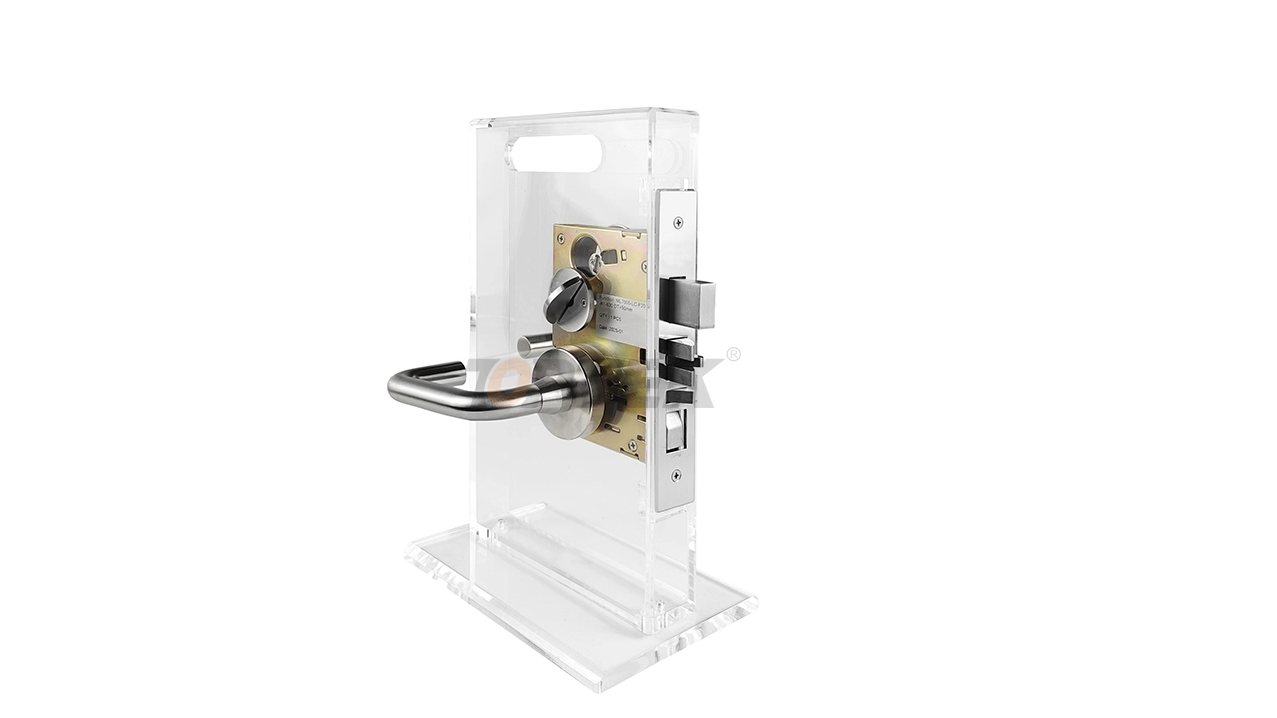Have you ever wondered about the mechanics behind the lock on your front door? Most residential and commercial buildings use cylindrical locks—the round, knob-style locks you turn and push to secure your home or office. Understanding how these common security devices function can help you make better decisions about your property's safety and know when it's time for repairs or upgrades.
A cylindrical lock operates through a precise system of pins, springs, and rotating cylinders that work together to secure your door. When you insert the correct key, it aligns internal components in a specific pattern, allowing the lock mechanism to turn and retract the latch bolt. This simple yet ingenious design has protected homes and businesses for decades, making it one of the most widely used locking mechanisms worldwide.
This guide will walk you through the inner workings of cylindrical locks, from their basic components to the step-by-step process of how they secure your property.
What Is a Cylindrical Lock?
A cylindrical lock is a type of door lock that features a round knob or lever handle connected to an internal locking mechanism. Unlike deadbolts, which require a separate installation, cylindrical locks combine the door handle and locking function into a single unit that fits through a large circular hole drilled into the door.
These locks are particularly popular because they're relatively inexpensive, easy to install, and provide adequate security for most residential applications. You'll find them on bedroom doors, bathroom doors, and many exterior entrances, though security experts often recommend pairing them with deadbolts for enhanced protection.
The term "cylindrical" refers to the shape of the lock's internal mechanism, which houses the key-operated cylinder within a round casing. This design allows the entire unit to fit snugly into the door while providing smooth operation and reliable security.
Key Components of a Cylindrical Lock
Understanding how a cylindrical lock functions requires familiarity with its essential parts. Each component plays a crucial role in the locking and unlocking process.
The Cylinder Assembly
The heart of any cylindrical lock is the cylinder assembly, which contains the keyway where you insert your key. This component houses the pin tumbler system that determines whether the lock will open. The cylinder rotates when the correct key is inserted, triggering the unlocking mechanism.
Pin Tumblers and Springs
Inside the cylinder, you'll find a series of pin tumblers—small metal pins of varying lengths that correspond to the cuts on your key. Each pin is paired with a spring that pushes it downward into the cylinder. When no key is present, these pins block the cylinder from rotating.
The Plug and Shell
The plug is the rotating part of the cylinder that turns when you insert and turn the correct key. It's surrounded by the shell, which remains stationary. The boundary between these two components is called the shear line, and proper pin alignment at this line is essential for the lock to function.
Latch Bolt and Strike Plate
The latch bolt is the curved metal piece that extends from the door edge into the door frame, actually securing the door. When you turn the knob or key, this bolt retracts, allowing the door to open. The strike plate on the door frame provides a secure housing for the latch bolt when the door is closed.
Knob or Lever Handle
The external handle allows you to operate the lock from either side of the door. On the exterior side, you typically need a key to unlock it, while the interior side often features a thumb turn or button for easy operation from inside.
The Step-by-Step Locking Process
When you close a door equipped with a cylindrical lock, several actions occur simultaneously to secure the entrance.
As the door closes, a spring mechanism automatically pushes the latch bolt into the extended position. The angled face of the latch bolt allows it to slide smoothly past the door frame as you close the door, then snap into place once the door is fully closed.
The latch bolt settles into the strike plate opening, creating a mechanical connection between the door and frame. This prevents the door from opening unless the latch bolt is retracted by turning the handle or using a key.
Many cylindrical locks also feature a button or switch that engages additional security measures, such as preventing the exterior handle from retracting the latch bolt even when turned. This feature is particularly common on bedroom and bathroom doors.

The Unlocking Mechanism Explained
The unlocking process demonstrates the precision engineering behind cylindrical locks. When you insert your key into the cylinder, each cut on the key pushes its corresponding pin tumbler to a specific height.
If you're using the correct key, all pin tumblers align perfectly at the shear line—the boundary between the rotating plug and stationary shell. This alignment removes the mechanical obstruction that prevents the cylinder from turning.
Once the pins are properly aligned, turning the key rotates the plug within the shell. This rotation activates a cam or actuator arm connected to the latch bolt mechanism, causing the bolt to retract and allowing the door to open.
The entire process happens in a fraction of a second, but it requires precise manufacturing tolerances to ensure smooth operation. Even a small variation in key cuts or pin lengths can prevent the lock from functioning properly.
Different Types of Cylindrical Locks
While all cylindrical locks operate on similar principles, several variations exist to meet different security and functional needs.
Entry Locks
Entry locks are designed for exterior doors and require a key to unlock from the outside. They typically feature a keyed cylinder on the exterior side and a thumb turn on the interior side for easy exit. These locks often include additional security features like longer latch bolts or reinforced construction.
Privacy Locks
Privacy locks are commonly used on bedroom and bathroom doors. Instead of a key cylinder, they feature a push-button or turn-button mechanism that locks the door from the inside. These locks usually include an emergency release feature that allows access from the outside using a small tool or coin.
Passage Locks
Passage locks function as door handles without any locking mechanism. They're used on closet doors, hallways, and other areas where security isn't necessary but you still need a handle to operate the door. The latch bolt retracts when either handle is turned.
Dummy Locks
Dummy locks are non-functional units used for aesthetic purposes on doors that don't require latching, such as French doors where only one door needs to function. They provide a uniform appearance while serving no actual security purpose.
Common Issues and Troubleshooting
Even well-made cylindrical locks can develop problems over time. Recognizing these issues can help you determine when professional repair or replacement is necessary.
Keys that stick or are difficult to turn often indicate worn pin tumblers or accumulated debris in the cylinder. Regular cleaning and lubrication can prevent many of these problems, but severely worn components may require replacement.
Latch bolts that don't fully extend or retract properly might have spring problems or misalignment issues. Sometimes adjusting the strike plate position can resolve these problems, but internal component failure requires professional attention.
If your lock turns but doesn't engage the latch bolt, the connection between the cylinder and bolt mechanism may be broken. This is a common issue in older locks where metal fatigue has caused internal components to fail.
Maintaining Your Cylindrical Lock
Proper maintenance extends the life of your cylindrical lock and ensures reliable operation. Clean the cylinder periodically with compressed air to remove dust and debris that can interfere with pin movement.
Use graphite lubricant rather than oil-based products, which can attract dirt and cause more problems over time. A small amount of graphite powder blown into the keyway will keep the pins moving smoothly.
Check the strike plate alignment regularly, especially if you notice the door becoming harder to close. Seasonal changes can cause doors and frames to shift slightly, affecting lock operation.
Understanding Your Home's Security
Cylindrical locks provide the foundation of your home's security system, but they work best as part of a comprehensive approach to property protection. While these locks offer convenience and adequate security for many applications, understanding their limitations helps you make informed decisions about additional security measures.
The precision engineering behind these everyday devices represents decades of refinement in mechanical security technology. By understanding how your cylindrical lock works, you're better equipped to maintain it properly and recognize when it's time for upgrades or repairs.
Geade two commercial Cylinderical
commercial Cylinderical
Cylindrical Lock
English
العربية
Français
Русский
Español
Português
Deutsch
italiano
日本語
한국어
Nederlands
Tiếng Việt
ไทย
Polski
Türkçe
አማርኛ
ພາສາລາວ
ភាសាខ្មែរ
Bahasa Melayu
ဗမာစာ
தமிழ்
Filipino
Bahasa Indonesia
magyar
Română
Čeština
Монгол
қазақ
Српски
हिन्दी
فارسی
Kiswahili
Slovenčina
Slovenščina
Norsk
Svenska
українська
Ελληνικά
Suomi
Հայերեն
עברית
Latine
Dansk
اردو
Shqip
বাংলা
Hrvatski
Afrikaans
Gaeilge
Eesti keel
Māori
සිංහල
नेपाली
Oʻzbekcha
latviešu
অসমীয়া
Aymara
Azərbaycan dili
Bamanankan
Euskara
Беларуская мова
भोजपुरी
Bosanski
Български
Català
Cebuano
Corsu
ދިވެހި
डोग्रिड ने दी
Esperanto
Eʋegbe
Frysk
Galego
ქართული
guarani
ગુજરાતી
Kreyòl ayisyen
Hausa
ʻŌlelo Hawaiʻi
Hmoob
íslenska
Igbo
Ilocano
Basa Jawa
ಕನ್ನಡ
Kinyarwanda
गोंगेन हें नांव
Krio we dɛn kɔl Krio
Kurdî
Kurdî
Кыргызча
Lingala
Lietuvių
Oluganda
Lëtzebuergesch
Македонски
मैथिली
Malagasy
മലയാളം
Malti
मराठी
ꯃꯦꯇꯥꯏ (ꯃꯅꯤꯄꯨꯔꯤ) ꯴.
Mizo tawng
Chichewa
ଓଡ଼ିଆ
Afaan Oromoo
پښتو
ਪੰਜਾਬੀ
Runasimi
Gagana Samoa
संस्कृत
Gaelo Albannach
Sepeti
Sesotho
chiShona
سنڌي
Soomaali
Basa Sunda
Wikang Tagalog
Тоҷикӣ
Татарча
తెలుగు
ትግንያውያን
Xitsonga
Türkmençe
संस्कृत
ئۇيغۇرچە
Cymraeg
isiXhosa
ייִדיש
Yorùbá
isiZulu





































